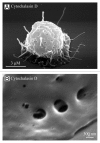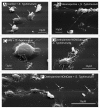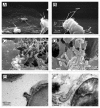Membrane tubulovesicular extensions (cytonemes): secretory and adhesive cellular organelles
- PMID: 23287580
- PMCID: PMC3655789
- DOI: 10.4161/cam.23130
Membrane tubulovesicular extensions (cytonemes): secretory and adhesive cellular organelles
Abstract
In this review, we summarized data on the formation and structure of the long and highly adhesive membrane tubulovesicular extensions (TVEs, membrane tethers or cytonemes) observed in human neutrophils and other mammalian cells, protozoan parasites and bacteria. We determined that TVEs are membrane protrusions characterized by a uniform diameter (130-250 nm for eukaryotic cells and 60-90 nm for bacteria) along the entire length, an outstanding length and high rate of development and a high degree of flexibility and capacity for shedding from the cells. This review represents TVEs as protrusions of the cellular secretory process, serving as intercellular adhesive organelles in eukaryotic cells and bacteria. An analysis of the physical and chemical approaches to induce TVEs formation revealed that disrupting the actin cytoskeleton and inhibiting glucose metabolism or vacuolar-type ATPase induces TVE formation in eukaryotic cells. Nitric oxide is represented as a physiological regulator of TVE formation.
Keywords: bacteria; cell secretion; cell-cell communications; cytonemes; eukaryotic cells; exocytotic carriers; host-pathogen interactions; membrane tethers; membrane tubulovesicular extensions (TVEs); protozoan parasites.
Figures





Similar articles
-
Cytonemes Versus Neutrophil Extracellular Traps in the Fight of Neutrophils with Microbes.Int J Mol Sci. 2020 Jan 16;21(2):586. doi: 10.3390/ijms21020586. Int J Mol Sci. 2020. PMID: 31963289 Free PMC article. Review.
-
Inhibition of the GTPase dynamin or actin depolymerisation initiates outward plasma membrane tubulation/vesiculation (cytoneme formation) in neutrophils.Biol Cell. 2015 May;107(5):144-58. doi: 10.1111/boc.201400063. Epub 2015 Mar 16. Biol Cell. 2015. PMID: 25655190
-
Proteome analysis identified human neutrophil membrane tubulovesicular extensions (cytonemes, membrane tethers) as bactericide trafficking.Biochim Biophys Acta. 2012 Nov;1820(11):1705-14. doi: 10.1016/j.bbagen.2012.06.016. Epub 2012 Jul 2. Biochim Biophys Acta. 2012. PMID: 22766193
-
Scanning electron microscopy study of neutrophil membrane tubulovesicular extensions (cytonemes) and their role in anchoring, aggregation and phagocytosis. The effect of nitric oxide.Exp Cell Res. 2005 Apr 1;304(2):620-9. doi: 10.1016/j.yexcr.2004.12.005. Epub 2005 Jan 18. Exp Cell Res. 2005. PMID: 15748905
-
Cytonemes and tunneling nanotubules in cell-cell communication and viral pathogenesis.Trends Cell Biol. 2008 Sep;18(9):414-20. doi: 10.1016/j.tcb.2008.07.003. Epub 2008 Aug 14. Trends Cell Biol. 2008. PMID: 18703335 Free PMC article. Review.
Cited by
-
Membrane nanotubes are ancient machinery for cell-to-cell communication and transport. Their interference with the immune system.Biol Futur. 2021 Mar;72(1):25-36. doi: 10.1007/s42977-020-00062-0. Epub 2021 Feb 8. Biol Futur. 2021. PMID: 34554502 Free PMC article. Review.
-
Caught red handed: modeling and confirmation of the myeloperoxidase ceruloplasmin alpha-thrombin complex.Biometals. 2022 Dec;35(6):1157-1168. doi: 10.1007/s10534-022-00432-2. Epub 2022 Aug 13. Biometals. 2022. PMID: 35962914 Free PMC article.
-
Neutrophils-From Bone Marrow to First-Line Defense of the Innate Immune System.Front Immunol. 2021 Dec 23;12:767175. doi: 10.3389/fimmu.2021.767175. eCollection 2021. Front Immunol. 2021. PMID: 35003081 Free PMC article. Review.
-
Cytonemes Versus Neutrophil Extracellular Traps in the Fight of Neutrophils with Microbes.Int J Mol Sci. 2020 Jan 16;21(2):586. doi: 10.3390/ijms21020586. Int J Mol Sci. 2020. PMID: 31963289 Free PMC article. Review.
-
Cytonemes and the dispersion of morphogens.Wiley Interdiscip Rev Dev Biol. 2014 Nov-Dec;3(6):445-63. doi: 10.1002/wdev.151. Epub 2014 Sep 3. Wiley Interdiscip Rev Dev Biol. 2014. PMID: 25186102 Free PMC article. Review.
References
Publication types
MeSH terms
Substances
LinkOut - more resources
Full Text Sources
Other Literature Sources
